混沌序列分析 (Chaotic Time Series Analysis)
- 格式:ppt
- 大小:7.21 MB
- 文档页数:41

《混沌时间序列盲估计方法研究》一、引言混沌时间序列分析是现代时间序列分析的重要分支,在许多领域如物理学、生物学、经济学和社会科学等领域都有着广泛的应用。
然而,由于混沌时间序列的复杂性和非线性特征,其估计和预测一直是一个具有挑战性的问题。
本文旨在研究混沌时间序列的盲估计方法,以期为相关领域的理论研究和实际应用提供有价值的参考。
二、混沌时间序列概述混沌时间序列是一种具有随机性、非周期性和敏感依赖于初始条件的复杂时间序列。
它常常表现出看似随机的行为,但背后却隐藏着确定的规律。
混沌时间序列的估计和预测对于理解其内在规律、预测未来趋势以及控制相关系统具有重要意义。
三、传统估计方法及其局限性传统的混沌时间序列估计方法主要包括参数化方法和非参数化方法。
参数化方法如自回归模型、移动平均模型等,通过设定一定的参数来描述时间序列的统计特性。
然而,这些方法往往难以准确描述混沌时间序列的非线性和随机性。
非参数化方法如神经网络、支持向量机等虽然能够在一定程度上提高估计精度,但往往需要大量的训练数据和计算资源。
四、盲估计方法研究针对传统方法的局限性,本文提出了一种基于数据驱动的盲估计方法。
该方法不依赖于先验知识和模型假设,而是直接从数据中提取信息来估计混沌时间序列。
具体包括以下几个步骤:1. 数据预处理:对混沌时间序列进行去噪、归一化等处理,以提高估计精度。
2. 特征提取:利用非线性分析方法如小波变换、分形分析等提取时间序列的内在特征。
3. 模型构建:基于提取的特征构建盲估计模型,如基于深度学习的自编码器、循环神经网络等。
4. 参数优化:通过优化算法如梯度下降法、遗传算法等优化模型的参数,以提高估计精度。
5. 估计与预测:利用优化后的模型对混沌时间序列进行估计和预测。
五、实验与分析为了验证本文提出的盲估计方法的有效性,我们进行了多组实验。
实验数据包括合成混沌时间序列和实际观测的混沌时间序列。
实验结果表明,本文提出的盲估计方法在估计精度和预测性能上均优于传统方法。
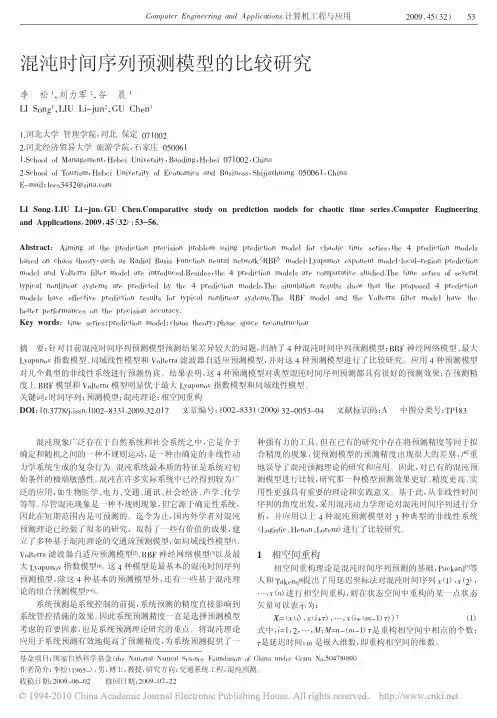

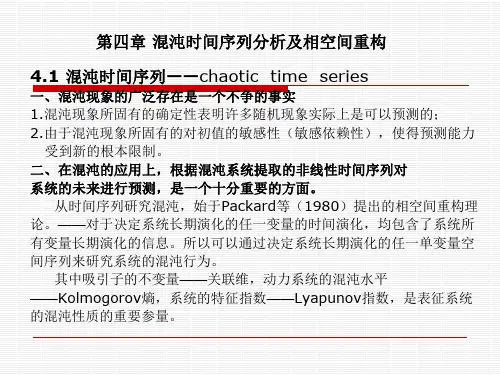

混沌论文:混沌序列特性分析及混沌同步技术研究【中文摘要】混沌现象是在非线性动态系统中出现的一种确定性的、类似随机的过程,这种过程非周期、是一种貌似无规则的运动,不收敛但有界,且对初始值具有极其敏感的依赖性,这些独特的性质使得混沌在保密通信、扩频通信等领域具有很好的应用前景。
随着对混沌现象研究的深入,混沌同步成为这一领域的关键课题。
本文介绍了混沌的一些基本理论,包括混沌的定义、研究现状、混沌的映射以及混沌的几种典型应用。
分析了四种典型混沌序列的统计特性,包括吸引子、李亚普诺夫指数、倍周期分岔、分形与维数、相位特性、功率谱特性、平衡性、游程特性、相关特性,并给出了仿真结果。
介绍了线性复杂度的定义,研究了Massey算法、经典的测度熵(K-S熵)算法、近似熵(ApEn)算法、排列熵(PE)算法、原生系数(IPP)算法以及Lempel-Ziv复杂度算法,并对四种典型的混沌映射的复杂度进行了详细的对比分析,给出了各种算法复杂度分析的数值。
介绍了混沌扩频通信的基本原理,提出了一种新的混沌扩频序列优选算法,并将产生的优化混沌扩频序列应用于DS/CDMA系统中,分别在不同干扰下进行了仿真,结果表明本文方法产生的优化混沌扩频序列的性能得到了很大地提高,能提供的系统容量较大,且具有很强的抗干扰能力。
系统地研究了驱动—响应同步法、相互耦合同步法、关联耦合同步法以及主动—被动同步法等几种常见的混沌同步技术,包括它们的基本原理以及实例仿真。
针对混沌测距系统的具体应用,设计了基于数字匹配滤波器的混沌码捕获与跟踪方案,并利用该方案设计了两种混沌测距的系统,验证了利用该系统进行测距的可行性,讨论了测距的工作过程、捕获时间和测距精度。
【英文摘要】Chaos is a convinced and similar random process that appears in the nonlinear system. It is also a non-periodic and irregular process. It is not convergent but has a bound, also it is sensitive to its initial values. For all these specical properties, chaos has good application prospect in the field of secure communication and spread spectrum communication. With the deepening studying to the chaos phenomenon, chaotic synchronization has become the improtant subject in this filed.This paper introduces the basic theories of chaos including the definition of chaos, the development of chaos technology, chaotic sequences map and their typical applications. Then the statistical properties of the four kinds chaotic sequences are analyzed, including attractor, Lyapunov exponents, bifurcation diagrams, fractal and dimension, phase characteristics, power spectrum characteristics, balance, run-length features, correlation, and the simulation results are given.The definition of linear complexity is introduced. The Massey algorithm, classical K-S entropy algorithm, approximate entropy (ApEn) algorithm, permutation entropy(PE)algorithm, index in primitive production process (IPP) algorithm and Lempel-Ziv complexity algorithm are studied. The complexities of the four kinds chaotic map are compared and analyzed. The values of various complexity algorithms analysis are given.The basic principles of chaotic spread spectrum communication are introduced. A new optimized selection algorithm of chaotic spread-spectrum sequence is proposed, and the optimal improved chaotic sequences are applied to DS/CDMA system in the presence of AWGN and different kinds of jamming. The results show that the chaotic spread-spectrum sequences generated by the proposed method have better correlation performance, larger capacity and excellent anti-jamming ability.Several chaotic synchronization technologies are studied, including PC synchronization, coupled synchronization, associated synchronization andactive-passive synchronization.Their basic principles and the example simulation are given. For the specific applications of chaotic ranging system, based on digital matched filter to achieve chaotic acquisition and tracking, two chaotic spread spectrum ranging schemes are designed, and their feasibilities, ranging processes, acquisition time and ranging accuracy are analyzed and validated.【关键词】混沌扩频通信复杂度优选算法混沌同步【英文关键词】Chaos Spread Spectrum Communication Complexity Optimization Algorithm Chaotic synchronnization【目录】混沌序列特性分析及混沌同步技术研究中文摘要3-4英文摘要4 1 绪论8-14 1.1 引言8 1.2 混沌的研究现状8-9 1.3 混沌映射及其应用9-12 1.3.1 混沌的定义9-10 1.3.2 混沌序列的产生10-11 1.3.3 混沌的几种典型应用11-12 1.4 本文的结构及主要内容安排12-14 2 混沌序列的统计特性分析14-34 2.1 吸引子14-16 2.2 李亚普诺夫指数16-18 2.3 倍周期分岔18-19 2.4 分形与维数19-20 2.5 相位特性20-21 2.6 功率谱特性21-22 2.7 平衡性22-25 2.8 游程特性25-26 2.9 相关特性26-32 2.9.1 混沌序列相关函数的定义26-27 2.9.2 四种混沌序列相关函数的仿真分析27-32 2.10 小结32-34 3 混沌序列的复杂度算法研究34-46 3.1 线性复杂度34-36 3.2 混沌序列的复杂度表示方法36-43 3.2.1 经典的测度熵(K-S熵)算法36 3.2.2 近似熵(ApEn)算法36-38 3.2.3 排列熵(PE)算法38-40 3.2.4 原生系数(IPP)算法40-42 3.2.5Lempel-Ziv复杂度算法42-43 3.3 小结43-46 4 混沌序列的优选算法研究46-56 4.1 DS/CDMA混沌系统46-47 4.2 混沌序列的优选准则和流程47-52 4.2.1 优选准则和流程47-51 4.2.2 仿真验证51-52 4.3 优选后混沌序列误码率性能分析52-55 4.4 小结55-56 5 混沌同步技术研究56-76 5.1 混沌同步的定义56 5.2 几种常见的混沌同步方法56-67 5.2.1 驱动响应同步法56-58 5.2.2 相互耦合同步法58-61 5.2.3 关联耦合同步法61-64 5.2.4 主动被动同步法64-67 5.3 混沌扩频测距系统的方案设计67-75 5.3.1 匹配滤波器捕获67-69 5.3.2 测距方案69-73 5.3.3 方案仿真73-75 5.4 小结75-76 6 总结与展望76-78 6.1 总结76-77 6.2 展望77-78致谢78-80参考文献80-84附录84 A. 作者在攻读学位期间发表的论文目录84 B. 作者在攻读学位期间参加的科研项目及取得的成果目录84。
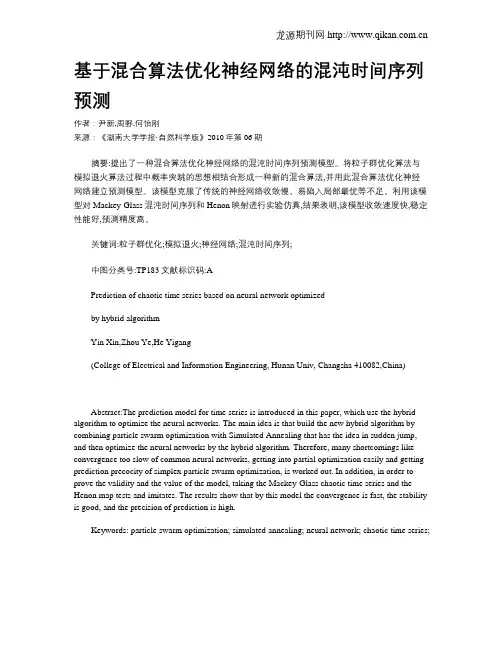
龙源期刊网 基于混合算法优化神经网络的混沌时间序列预测作者:尹新,周野,何怡刚来源:《湖南大学学报·自然科学版》2010年第06期摘要:提出了一种混合算法优化神经网络的混沌时间序列预测模型。
将粒子群优化算法与模拟退火算法过程中概率突跳的思想相结合形成一种新的混合算法,并用此混合算法优化神经网络建立预测模型。
该模型克服了传统的神经网络收敛慢、易陷入局部最优等不足。
利用该模型对Mackey-Glass混沌时间序列和Henon映射进行实验仿真,结果表明,该模型收敛速度快,稳定性能好,预测精度高。
关键词:粒子群优化;模拟退火;神经网络;混沌时间序列;中图分类号:TP183文献标识码:APrediction of chaotic time series based on neural network optimizedby hybrid algorithmYin Xin,Zhou Ye,He Yigang(College of Electrical and Information Engineering, Hunan Univ, Changsha 410082,China)Abstract:The prediction model for time series is introduced in this paper, which use the hybrid algorithm to optimize the neural networks. The main idea is that build the new hybrid algorithm by combining particle swarm optimization with Simulated Annealing that has the idea in sudden jump, and then optimize the neural networks by the hybrid algorithm. Therefore, many shortcomings like convergence too slow of common neural networks, getting into partial optimization easily and getting prediction precocity of simplex particle swarm optimization, is worked out. In addition, in order to prove the validity and the value of the model, taking the Mackey-Glass chaotic time series and the Henon map tests and imitates. The results show that by this model the convergence is fast, the stability is good, and the precision of prediction is high.Keywords: particle swarm optimization; simulated annealing; neural network; chaotic time series;。

混沌时间序列分析方法研究及其应用一、综述近年来,随着大数据时代的到来,时间序列数据在各个领域的应用越来越广泛,如金融、气象、环境监测、生物技术等。
对于时间序列数据,由于其具有不确定性、复杂性和模糊性等特点,传统的数据分析方法已经难以满足需求。
针对时间序列数据的混沌时间序列分析方法逐渐受到关注。
本文将对混沌时间序列分析方法进行综述,包括其基本原理、特点、应用以及最新研究成果。
旨在为相关领域的研究和应用提供参考与借鉴。
混沌时间序列分析方法是一种针对具有混沌特性的时间序列数据进行预测和分析的方法。
自从20世纪80年代以来,混沌理论的发展为时间序列分析提供了新的思路。
与其他数据分析方法相比,混沌时间序列分析方法具有对初始条件敏感、普适性、可预测性等特点,使其在许多领域得到广泛应用。
相空间重构:通过对时间序列进行相空间重构,将高维的时间序列数据投影到低维的相空间中,以揭示其内在的混沌动力学规律。
常用的重构方法有CohenSteel算法、拉普拉斯矩阵和马尔可夫矩阵等。
李雅普诺夫指数计算:李雅普诺夫指数是衡量系统混沌程度的一个指标。
通过对时间序列进行分析,可以计算出其李雅普诺夫指数,从而了解系统的混沌特性。
常用的计算方法有奇异值分解法(SVD)和非线性最小二乘法等。
分布熵分析:分布熵是一种衡量时间序列复杂性的度量。
通过对时间序列进行分布熵分析,可以了解其混乱程度。
常用的分布熵计算方法有基于Shannon熵的算法和基于小波嫡的算法等。
神经网络预测:基于神经网络的混沌时间序列预测方法被认为是具有潜力的预测手段。
通过训练神经网络模型,可以实现对混沌时间序列的有效预测。
主要包括循环神经网络(RNN)、长短时记忆网络(LSTM)和门控循环单元(GRU)等模型。
集成学习方法:集成学习方法是将多个单一模型的预测结果进行融合以提高预测精度的策略。
通过对不同算法和模型的预测结果进行集成,可以提高混沌时间序列分析的稳定性和准确性。
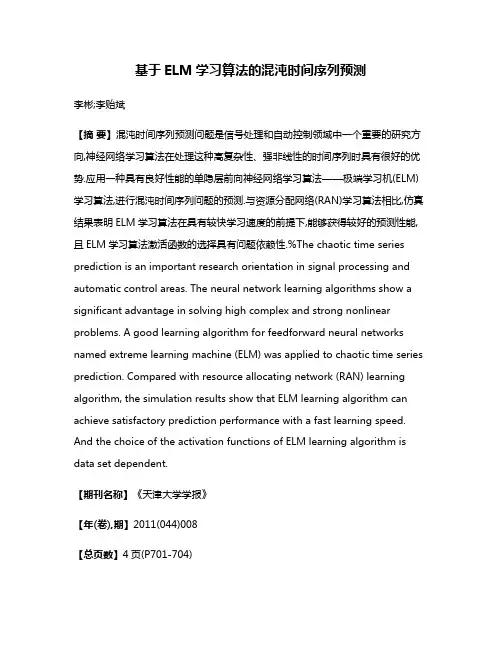
基于ELM学习算法的混沌时间序列预测李彬;李贻斌【摘要】混沌时间序列预测问题是信号处理和自动控制领域中一个重要的研究方向,神经网络学习算法在处理这种高复杂性、强非线性的时间序列时具有很好的优势.应用一种具有良好性能的单隐层前向神经网络学习算法——极端学习机(ELM)学习算法,进行混沌时间序列问题的预测.与资源分配网络(RAN)学习算法相比,仿真结果表明ELM学习算法在具有较快学习速度的前提下,能够获得较好的预测性能,且ELM学习算法激活函数的选择具有问题依赖性.%The chaotic time series prediction is an important research orientation in signal processing and automatic control areas. The neural network learning algorithms show a significant advantage in solving high complex and strong nonlinear problems. A good learning algorithm for feedforward neural networks named extreme learning machine (ELM) was applied to chaotic time series prediction. Compared with resource allocating network (RAN) learning algorithm, the simulation results show that ELM learning algorithm can achieve satisfactory prediction performance with a fast learning speed. And the choice of the activation functions of ELM learning algorithm is data set dependent.【期刊名称】《天津大学学报》【年(卷),期】2011(044)008【总页数】4页(P701-704)【关键词】混沌时间序列;极端学习机;激活函数;预测【作者】李彬;李贻斌【作者单位】山东大学控制科学与工程学院,济南250061;山东轻工业学院数理学院,济南250353;山东大学控制科学与工程学院,济南250061【正文语种】中文【中图分类】TP183混沌系统是一个确定的非线性动态系统,由这种系统产生的混沌信号对初始条件比较敏感,难以长期预测.混沌理论和混沌信号的处理是现阶段的一个热点研究问题,混沌时间序列(混沌信号)是对一个混沌系统采样得到的单变量时间序列.为了更好地研究混沌系统,如何对这种高度复杂,强非线性的混沌信号进行建模和预测,是当前的一个难点和热点问题.神经网络作为一种数据驱动的结构和算法,具有逼近任意非线性函数的能力,可以映射出数据之间的非线性关系.从而使得神经网络成为混沌时间序列预测的一个强有力的工具.文献[1-3]中,分别探讨了径向基函数(radial basis function,RBF)神经网络、BP(back propagation)神经网络、模糊神经网络等对混沌时间序列问题的预测.现存的这些方法存在很多缺点,一般算法比较复杂,均为批处理学习算法,不能进行实时的在线学习,很多参数需要人工调整,预测精度不高,收敛速度慢或容易陷入局部极小点,算法运行的时间较长等.2006 年,Huang 等[4]提出了一类性能优良的单隐层前向神经网络(single-hidden layer feed forward neural networks,SLFNs)学习算法,称为极端学习机(extreme learning machine,ELM)学习算法,与一般的BP 神经网络、RBF神经网络相比,性能较好.该算法可以随机地选择网络中隐层神经元个数和类型,构造不同的学习算法,且在随机选择输入层权值和隐层神经元偏差(阈值)前提下,可以解析获得隐层输出权值,该方法具有许多优良的特性,如学习速度快,泛化能力好等.ELM 学习算法和理论[4-6]经过许多学者的努力,已在函数逼近、模式分类、系统辨识等方面得到广泛应用.本文将ELM 学习算法用于混沌时间序列预测,扩展了这种算法的应用范围.仿真结果表明,ELM 学习算法所处理的混沌时间序列,预测精度较高,学习速度较快.并且针对同一问题,在网络复杂度相同的前提下,选择不同的激活函数,ELM 学习算法性能差异较大,即ELM 学习算法激活函数的选择具有问题依赖性.1 ELM学习算法简介具有个隐层神经元的SLFNs 的输出为式中:G ( w i , bi, x)为与输入x 对应的第i 个隐层神经元的输出;β i=[β i1,βi2,···,βim]T为第i 个隐层神经元与输出神经元之间的连接权向量.当激活函数g(x)为加性神经元时,第i 个隐层神经元的输出为式中:是第i 个隐层神经元与输入神经元之间的权向量;bi是第i 个隐层神经元的偏差.当激活函数g(x)为RBF 神经元时,其相应的输出为式中:wi和 bi 分别为第i 个径向基函数的中心和影响因子(宽度);R+是一个正实数集合.对于 N 个任意输入样本(xj,tj),其中,给定个隐层神经元和激活函数G(wi,bi,x),则存在βi,wi和 bi ,使得SLFNs 能够以零误差逼近这N 个样本点,即式(4)可以写成矩阵形式为其中式中:H 是该神经网络的隐层输出矩阵,H 的第i 列是关于输入x1,x2,… ,xN 的第i 个隐层神经元的输出.对于单隐层前向神经网络,ELM 学习算法对于任意无限可微的激活函数都是可用的[4-5],从而拓展了前向神经网络激活函数的选择空间.与传统的函数逼近理论不同,ELM 学习算法的输入层权值 w i和隐层的偏差 bi 可以随机选择[4].从而,对于前向神经网络来说,在网络的训练过程中,无需对输入层权值和隐层偏差进行调整,一旦这些参数随机确定以后,隐层输出矩阵H 在网络开始训练时,保持不变.从而,SLFNs 的训练过程,等价于寻找线性系统H β =T的最小二乘解,如果隐层神经元的个数和网络的输入样本个数N 相同,即= N,当输入层权值和隐层偏差随机确定以后,矩阵H 是可逆方阵,则该SLFNs 能够以零误差逼近训练样本.但是,在大多数情况下≪ N,矩阵H 不是方阵,从而不存在使得=Hβ=T.但是可以求这个线性系统的最小范数最小二乘解:=H+T ,其中 H +为矩阵H 的Moore-Penrose 广义逆.ELM 学习算法总结为:给定一个训练样本集,激活函数g(x),隐层神经元个数,具体步骤如下.步骤1 随机设定输入层权值wi 和偏差bi,i =1,…,,.步骤 2 计算隐层输出矩阵H .步骤3 计算输出层权值β: = H +T ,其中 T=2 计算机仿真与结果分析本文用Box and Jenkins gas furnace data[7]和Mackey-Glass[8]混沌时间序列预测问题来进行计算机仿真.ELM 学习算法的隐层神经元个数和激活函数类型,根据所处理的问题进行选取,以期得到较好的逼近误差和泛化能力.本文所有结果都是在Matlab 7.0 环境下,CPU 为1.7,GHz 的奔腾Ⅳ机器上运行得到的,为了使算法更有说服力,表中的结果为10 次仿真结果的平均值,算法性能用均方根误差衡量.在Box and Jenkins gas furnace data 基准问题中,原始数据点个数为296 个,其中 u(t)为输入气体流速,y (t )为输出CO2 浓度,用{ y(t − 1), y ( t − 2), y(t −3),y(t − 4),u (t− 1),u (t − 2),u (t − 3),u (t − 4),u (t −5),u(t − 6)}时刻的值来预测 y (t )时刻的值.这里取的有效数据点个数为290 个,前200 个为训练样本,后90个作为测试样本.Mackey-Glass 微分延迟方程被认为是一个混沌时间序列基准问题.它由下面的微分延迟方程产生,式中:a = 0.2;b = 0.1;τ = 17.用微分延迟方程生成的Mackey-Glass 时间序列个数为4,500,其中的前4,000 数据用来训练网络,后500 个作为网络的测试数据,来测试网络的泛化能力.在同一激活函数下,神经网络中隐层激活函数个数越多,逼近能力越好,但是有可能出现过拟合现象,使得神经网络的泛化能力降低.因此,为了获得较好的网络性能,必须适当地选择合适的隐层神经元个数.为了使得ELM 学习算法有比较好的性能,在Box and Jenkins gas furnace data 和Mackey-Glass 混沌时间序列预测中,隐层神经元个数分别为15和200.如表1 所示,对于Box and Jenkins gas furnace data 基准问题,在相同的网络复杂度(隐层神经元个数相同)前提下,线性(linear)激活函数性能表现良好,和其他激活函数相比,其训练误差和测试误差都较小,2 种误差的标准偏差为0,网络的稳定性较好.而对于Mackey-Glass 混沌时间序列问题来说,当激活函数为sigmoid时,网络的性能表现较好.仿真结果表明对于相同的网络复杂度,选择不同的激活函数,同样的问题性能表现有很大的不同,即ELM 学习算法中激活函数的选择具有问题依赖性.因此,在同样网络复杂度前提下,根据实际问题选择不同的激活函数对设计高性能的ELM 前向神经网络是重要的.表1 不同激活函数条件下ELM学习算法关于混沌时间序列预测问题的性能比较Tab.1 Performance comparison of ELM learning algorithm with different activation functions for chaotic time series prediction problems数据训练误差标准偏差测试误差标准偏差激活函数类型网络复杂度0.014 6 0 0.018 9 0 linear 15 Box and Jenkins gas furnace data 0.017 8 0.002 3 0.022 0 0.002 9 sigmoid 15 0.236 8 0.082 5 0.263 2 0.086 8 RBF15 0.048 6 0.011 8 0.051 0 0.014 9 cubic 15 0.021 5 0.001 9 0.024 2 0.002 0 sine 15 0.043 0 9.944 3×10-5 0.010 5 3.527 7×10-4 sigmoid 200 Mackey-Glass 0.163 6 0 0.155 2 0 linear 200 0.077 4 0 0.064 8 0 cubic 200 0.048 2 5.233 4×10-4 0.024 6 0.001 4 RBF 200 0.043 1 3.162 3×10-5 0.011 0 2.121 3×10-4 sine 200图1和图2 分别为2个混沌时间序列问题的预测曲线,从图上可以看出,在适当的选择激活函数类型和隐层神经元个数前提下,ELM 学习算法比较适合处理复杂的混沌时间序列预测问题,能严格地跟踪拟合这些高度复杂、强非线性曲线.图1 ELM 学习算法关于Box and Jenkins 煤气炉混沌时间序列预测问题的预测曲线(线性激活函数)Fig.1 Prediction curve of ELM learning algorithm for Fig.1 Box and Jenkins gas furnace chaotic time series Fig.1 prediction problems (linear activation function)图2 ELM学习算法关于Mackey-Glass混沌时间序列预测问题的预测曲线(sigmoid 激活函数)Fig.2 Prediction curve of ELM learning algorithm for Fig.2 Mackey-Glass chaotic time series prediction pro-Fig.2 blems(sigmoid activation function)为了更好地体现ELM 学习算法的优良性能,本文比较了ELM 和资源分配网络(resource allocating network,RAN)[9]径向基函数神经网络学习算法.除期望输出误差取值为0.001 之外,RAN 学习算法的其他参数选取和文献[8]一样.从表2 可以看出,在相同的网络复杂度前提下,和RAN 学习算法相比,ELM 学习算法的训练时间、训练误差和测试误差都较小,更适合于混沌时间序列问题的预测.表2 ELM和RAN学习算法在混沌时间序列预测问题的性能比较Tab.2 Performance comparison of ELM and RAN learning algorithms for chaotic time series prediction problems数据算法 CPU 时间/s 训练误差测试误差网络复杂度RAN 60.60 0.072 7 0.091 1 7 Box and Jenkins gas furnace data ELM 60.01 0.028 8 0.029 8 7 RAN 65.00 0.091 10.037 3 70 Mackey-Glass ELM 60.29 0.052 2 0.030 5 703 结语本文将ELM 学习算法应用于混沌时间序列预测,与其他方法不同,ELM 学习方法在随机选择输入层权值和隐层偏差的前提下,可以解析获得隐层输出权值,算法简单,执行速度很快.与RAN 学习算法相比,仿真表明对于混沌时间序列预测问题,ELM 学习算法具有较好的性能.同时也说明了对于同样的问题,ELM 学习算法中,选择不同激活函数,性能表现差异明显,即ELM 激活函数的选择具有问题依赖性.针对不同问题,激活函数的选择一般有2 种方式:一种是把从所处理问题中提取的先验知识耦合进神经网络算法当中[10];另一种是选择激活函数自适应可调的神经网络学习算法.因此,根据实际问题选择不同的神经网络激活函数对设计高性能的极端学习机前向神经网络是重要的,也为将来设计激活函数自适应可调的ELM学习算法提供了一定的理论基础.【相关文献】[1]李冬梅,王正欧. 基于RBF 神经网络的混沌时间序列预测[J]. 模式识别与人工智能,2001,14(2):231-234.Li Dongmei,Wang Zheng’ou. Prediction of chaotic time series based on RBF neural networks[J]. Pattern Recognition and Artificial Intelligence,2001,14(2):231-234(in Chinese).[2]郁俊莉. 基于混沌时间序列的非线性动态系统神经网络建模与预测[J]. 武汉大学学报:理学版,2005,51(3):286-290.Yu Junli. Modeling and forecasting of the nonlinear dynamic system neural network based on the chaotic time series[J]. Journal of Wuhan University:Natural Science Edition,2005,51(3):286-290(in Chinese).[3]Maguire L P,Roche B,McGinnity T M,et al. Predicting a chaotic time series using a fuzzy neural network[J].Information Sciences,1998,112(1/2/3/4):125-136.[4]Huang G B,Zhu Q Y,Siew C K. Extreme learning machine : Theory and applications[J]. Neurocomputing,2006,70(1/2/3):489-501.[5]Huang G B,Siew C K. Extreme learning machine with randomly assigned RBF kernels[J]. International Journal of Information Technology,2005,11(1):16-24.[6]Li M B,Er M J. Nonlinear system identification using extreme learning machine[C]// Ninth International Conference on Control,Automation,Robotics and Visio.Singapore,2006:1-4.[7]Rojas I,Gonzalez J,Canas A,et al. Short-term prediction of chaotic time series by using RBF network with regression weights[J]. International Journal of Neural Systems,2000,10(5):353-364.[8]李彬,赖晓平. 改进的GGAP-RBF 算法及其在函数逼近中的应用[J]. 模式识别与人工智能,2007,20(2):230-235.Li Bin,Lai Xiaoping. An improved GGAP-RBF algorithm and its application to function approximation[J].Pattern Recognition and Artificial Intelligence,2007,20(2):230-235(in Chinese).[9]Platt J. A resource-allocating network for function interpolation neural computation[J]. Neural Computation,1991,3(2):213-225.[10]韩飞. 基于先验信息编码的约束学习算法研究[D].合肥:中国科学技术大学自动化系,2006.Han Fei. A Study of Constrained Learning Algorithms Encoding the a PrioriInformation of Problem[D].Hefei:Department of Automation,University of Science and Technology of China,2006(in Chinese).。
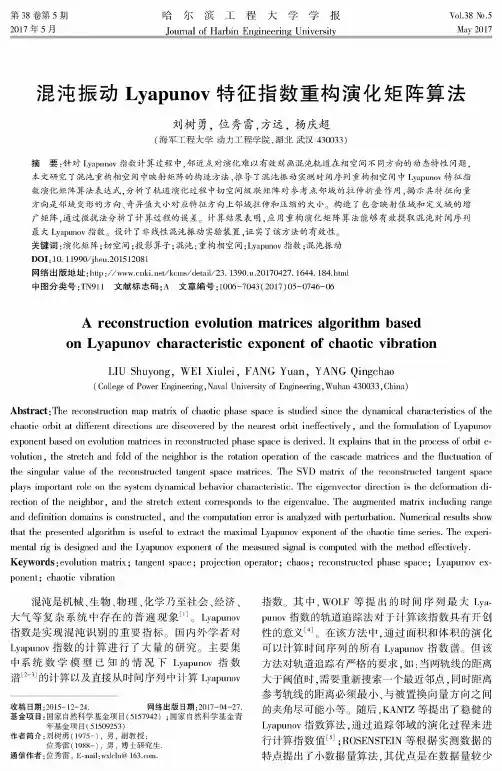
第38卷第5期2017年5月哈尔滨工程大学学报Journal o!Harbin Engineering UniversityVol.38 No.5May 2017混沌振动Lyapunov特征指数重构演化矩阵算法刘树勇,位秀雷,方远,杨庆超(海军工程大学动力工程学院,湖北武汉430033)摘要:针对Lyapunov指数计算过程中,邻近点对演化难以有效刻画混沌轨道在相空间不同方向的动态特性问题,本文研究了混沌重构相空间中映射矩阵的构造方法,推导了混沌振动实测时间序列重构相空间中Lyapunov特征指 数演化矩阵算法表达式,分析了轨道演化过程中切空间级联矩阵对参考点邻域的拉伸折叠作用,揭示其特征向量 方向是邻域变形的方向、奇异值大小对应特征方向上邻域拉伸和压缩的大小。
构造了包含映射值域和定义域的增 广矩阵,通过微扰法分析了计算过程的误差。
计算结果表明,应用重构演化矩阵算法能够有效提取混沌时间序列 最大Lyapunov指数。
设计了非线性混沌振动实验装置,证实了该方法的有效性。
关键词:演化矩阵;切空间;投影算子;混沌;重构相空间;Lyapunov指数;混沌振动DOI:10. 11990/jheu.201512081网络出版地址:http :///kcms/detaiV23. 1390.u.20170427. 1644. 184.html中图分类号:TN911 文献标志码:A 文章编号:1006-7043(2017)05-0746-06A r e c o n s t r u c t i o n e v o l u t i o n m a t r i c e s a l g o r i t h m b a s e do n L y a p u n o v c h a r a c t e r i s t i c e x p o n e n t o f c h a o t i c v i b r a t i o nLIU Shuyong,WEI Xiulei,FANG Yuan,YANG Qingchao(College of Power Engineering,Naval University of Engineering,Wuhan 430033,China)Abstract:The reconstruction map matrix o!chaotic phase space i s studied since the dynamical characteristics o!the chaotic orbit at different directions are discovered by the nearest orbit ineffectively,and the formulation o f Lyapunov exponent based on evolution matrices in reconstructed phase space i s derived.I t explains that in the process of orbit e-volution,the stretch and fold o f the neighbor i s the rotation operation of the cascade matrices and the fluctuation o f the singular value o f the reconstructed tangent space matrices.The S V D matrix o f the reconstructed tangent space plays important role on the system dynamical behavior characteristic.The eigenvector direction i s the deformation direction of the neighbor,and the stretch extent corresponds to the eigenvalue.The augmented matrix including range and definition domains i s constructed,and the computation error i s analyzed with perturbation.Numerical results show that the presented algorithm i s useful to extract the maximal Lyapunov exponent o f the chaotic time series.The experimental r ig i s designed and the Lyapunov exponent o f the measured signal i s computed with the method effectively.K e y w o r d s:evolution matrix;tangent space;projection operator;chaos;reconstructed phase space;Lyapunov exponent;chaotic vibration混沌是机械、生物、物理、化学乃至社会、经济、大气等复杂系统中存在的普遍现象⑴。
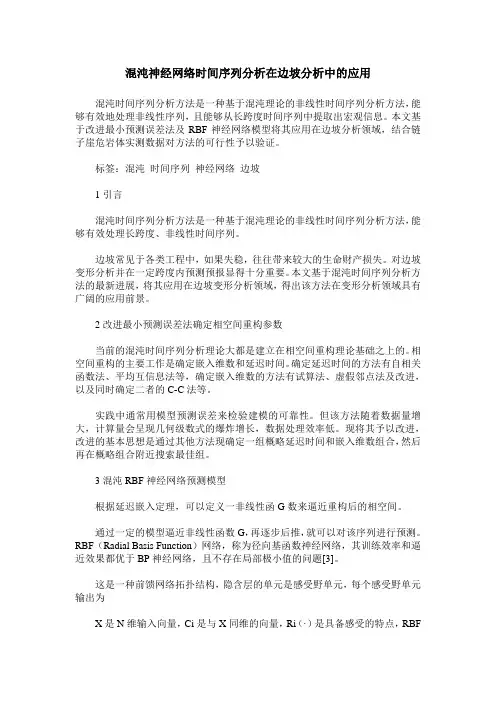
混沌神经网络时间序列分析在边坡分析中的应用混沌时间序列分析方法是一种基于混沌理论的非线性时间序列分析方法,能够有效地处理非线性序列,且能够从长跨度时间序列中提取出宏观信息。
本文基于改进最小预测误差法及RBF神经网络模型将其应用在边坡分析领域,结合链子崖危岩体实测数据对方法的可行性予以验证。
标签:混沌时间序列神经网络边坡1引言混沌时间序列分析方法是一种基于混沌理论的非线性时间序列分析方法,能够有效处理长跨度、非线性时间序列。
边坡常见于各类工程中,如果失稳,往往带来较大的生命财产损失。
对边坡变形分析并在一定跨度内预测预报显得十分重要。
本文基于混沌时间序列分析方法的最新进展,将其应用在边坡变形分析领域,得出该方法在变形分析领域具有广阔的应用前景。
2改进最小预测误差法确定相空间重构参数当前的混沌时间序列分析理论大都是建立在相空间重构理论基础之上的。
相空间重构的主要工作是确定嵌入维数和延迟时间。
确定延迟时间的方法有自相关函数法、平均互信息法等,确定嵌入维数的方法有试算法、虚假邻点法及改进,以及同时确定二者的C-C法等。
实践中通常用模型预测误差来检验建模的可靠性。
但该方法随着数据量增大,计算量会呈现几何级数式的爆炸增长,数据处理效率低。
现将其予以改进,改进的基本思想是通过其他方法现确定一组概略延迟时间和嵌入维数组合,然后再在概略组合附近搜索最佳组。
3混沌RBF神经网络预测模型根据延迟嵌入定理,可以定义一非线性函G数来逼近重构后的相空间。
通过一定的模型逼近非线性函数G,再逐步后推,就可以对该序列进行预测。
RBF(Radial Basis Function)网络,称为径向基函数神经网络,其训练效率和逼近效果都优于BP神经网络,且不存在局部极小值的问题[3]。
这是一种前馈网络拓扑结构,隐含层的单元是感受野单元,每个感受野单元输出为X是N维输入向量,Ci是与X同维的向量,Ri(·)是具备感受的特点,RBF网络具有严密的数学理论支持[4]。
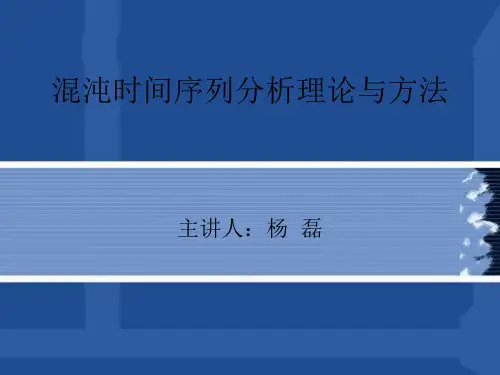
连续混沌系统时间序列的可视图分析张蓉;邹勇【期刊名称】《中国科技论文》【年(卷),期】2016(011)005【摘要】以连续混沌系统时间序列为例,通过可视图方法分析其可行性,研究结果表明网络的度分布并不是幂率分布;并且发现同一个混沌系统的两个变量所对应的度序列之间存在很大的关联性,且序列中大数值点基本上都没有成为网络中的大度点。
通过详细的对比分析得出时间序列的二阶导数和网络度大的节点间存在一定关系。
可视图的全局统计量可以很好刻画系统的分岔过程,因此,可视图方法完全可以用来分析连续混沌系统的时间序列。
%By applying visibility graph analysis to time series produced by continuous chaotic systems,degree distributions of the resulted networks are shown to be non-power laws.Degree sequences of two variables have strongcorrelations.Furthermore, large sampled values of the series are not transformed into hubs in the networks.A detailed comparative analysis shows that there are some mild correlations between the degree sequence and the associated second derivative of underlying time series.The bifur-cation process has been successfully captured by the global network statistical measures,which therefore suggests that visibility graphs can be used to analyze time series of continuous chaotic systems.【总页数】4页(P554-556,565)【作者】张蓉;邹勇【作者单位】华东师范大学物理系,上海 200062;华东师范大学物理系,上海200062【正文语种】中文【中图分类】Q415.5【相关文献】1.基于SE和C0算法的连续混沌系统复杂度分析 [J], 叶晓林;牟俊;王智森;金基宇;张蕾;刘恩萌2.矿井构造系统的混沌时间序列分析 [J], 汪吉林;姜波3.基于混沌动力学系统高程时间序列分析 [J], 张思慧;李琳;黄声和;朱明栓4.连续混沌系统时间序列的可视图分析 [J], 张蓉;邹勇;5.有界噪声激励下对称不连续系统的混沌分析 [J], 贺文娟; 李晶; 刘迪因版权原因,仅展示原文概要,查看原文内容请购买。
第36卷第3期计算机仿真2019年3月文章编号:1006-9348(2019)03-0448-05基于VM D和GRNN的混沌时间序列预测杨洪军,徐娟娟,刘杰(内蒙古大学满洲里学院,内蒙古满洲里021400)摘要:随着非线性混沌动力学的发展,混沌时间序列的预测已经成为一个非常重要的研究方向。
针对混沌时间序列的非线 性和非平稳性的特点,提出一种变模态分解(VMD)和广义神经网络(GRNN)相结合的混沌时间序列预测方法,首先将混沌 时间序列分解为多个固有模态函数(IMF)和余量(RF),然后对每个分量建立GRNN预测模型,最后将各分量的预测结果之 和作为混沌时间序列的预测结果。
采用Mackey-Glass混沌时间序列作为仿真实例,实验结果表明VMD-GRNN模型的预测 精度相对于BP、ARMA和EMD-GRNN均有提高,证明了上述方法的有效性。
关键词:变分模态分解;广义回归神经网络;混沌时间序列;预测中图分类号:TP391.2 文献标识码:BChaotic Time Series Prediction Using Variational Mode Decomposition and Generalized Regression Neural NetworkYANG Hong-jun,XU Juan-juan,LIU Jie(College of Manzhouli, Inner Mongolia University, Manzhouli Inner Mongolia 021400, China)A B S T R A C T:With the development of nonlinear chaotic dynamics, the prediction of chaotic time series has become avery important research direction.In view of the complexity, nonlinearity and nonstationarity of chaotic time series, a chaotic time series prediction model i s proposed based on V M D and generalized neural network (G R N N).Firstly, the sequence was decomposed i nto several i n t r i n s i c mode functions (IMF) and residual (R F); then a G R N N predict ion model f o r each component was established.Finally, the prediction results of each component were taken as the prediction resu l t s of nonlinear time series.The method was applied t o Mackey-Glass chaotic time series prediction.The simulation resu l t s show t hat the V M D-G R N N models have higher predication accuracy compared with B P, A R-M A and E M D-G R N N, thus i l l u s t r a t e the effectiveness of the method.K E Y W O R D S:V M D;G R N N;Chaotic time series;Forecastingi引言随着非线性混沌动力学的快速发展,混沌时间序列的预 测和建模已经成为非常重要的研究方向,并已在信号处理和 金融预测等领域中得到了广泛的应用[1]。
基于均匀设计优化预测模型参数的混沌时间序列预测陈海英;吴明慧【摘要】In order to solve the optimisation problems of delaytime,dimension embedding and model parameters in chaotic time series prediction,we propose a prediction model of chaotic time series which is based on optimising prediction model parameters with uniformdesign.First we use uniform design to produce multiple parameter combinations,and use least square service vector machine (LSSVM)to obtain the root mean square error (RMSE)of every group of parameters.Secondly,we use LSSVM to conduct full combination optimisation on parameters to build the optimal chaotic time prediction model.Finally,the simulation experiments are carried out on chaotic time series. Simulation result illustrates that in comparison with contrasting models,the proposed model can quickly and accurately find the optimal combination of delay time,dimension embedding and model parameters,and the prediction accurate of chaotic time series is improved as well.%为解决混沌时间序列预测中的延迟时间、嵌入维与模型参数等优化问题,提出一种基于均匀设计优化预测模型参数的混沌时间序列预测模型(UD-LSSVM)。
外文文献翻译Short Term Chaotic Time Series Predictionusing Symmetric LS-SVM RegressionAbstract—In this article, we illustrate the effect of imposing symmetry as prior knowledge into the modelling stage, within the context of chaotic time series predictions. It is illustrated that using Least-Squares Support Vector Machines with symmetry constraints improves the simulation performance, for the cases of time series generated from the Lorenz attractor, and multi-scroll attractors. Not only accurate forecasts are obtained, but also the forecast horizon for which these predictions are obtained is expanded.1. IntroductionIn applied nonlinear time series analysis, the estimation of a nonlinear black-box model in order to produce accurate forecasts starting from a set of observations is common practice. Usually a time series model is estimated based on available data up to time t, and its final assessment is based on the simulation performance from t + 1 onwards. Due to the nature of time series generated by chaotic systems, where the series not only shows nonlinear behavior but also drastic regime changes due to local instability of attractors, this is a very challenging task. For this reason, chaotic time series have been used as benchmark in several time series competitions.The modelling of chaotic time series can be improved by exploiting some of its properties. If the true underlying system is symmetric, this information can be imposed to the model as prior knowledge ,in which case it is possible to obtain better forecasts than those obtained with a general model . In this article, short term predictions for chaotic time series are generated using Least-Squares Support Vector Machines (LS-SVM) regression. We show that LS-SVM with symmetry constraints can produce accurate predictions. Not only accurate forecasts are obtained, but also the forecast horizon for which these predictions are obtained is expanded, when compared with the unconstrained LS-SVM formulation.This paper is structured as follows. Section 2 describes the LS-SVM technique for regression, and how symmetry can be imposed in a straightforward way.Section 3 describes the applications for the cases of the x−coordinate of the Lorenz attractor, and the data generated by a nonlinear transformation of multi-scroll attractors.2. LS-SVM with Symmetry ConstraintsLeast-Squares Support Vector Machines (LS-SVM) is a powerful nonlinear black-box regression method,which builds a linear model in the so-called feature space where the inputs have been transformed by means of a (possibly infinite dimensional) nonlinear mapping . This is converted to the dual space by means of the Mercer’s theorem and the use of a positive definite kernel, without computing explicitly the mapping. The LS-SVM formulation, solves a linear system in dual space under a least-squares cost function , where the sparseness property can be obtained by e.g. sequentially pruning the support valuespectrum or via a fixed-size subset selection approach. The LS-SVM training procedure involves the selection of a kernel parameter and the regularization parameter of the cost function, which can be done e.g. by cross-validation, Bayesian techniques or others. The inclusion of a symmetry constraint (odd or even) to the nonlinearity within the LS-SVM regression framework can be formulated as follows . Given the sample of N points {},1k k N x y k =, with input vectors p k x R ∈and output values k y R ∈, the goal is to estimate a model of the form ()T y w x b e ϕ=++():hn p R R ϕ∙→ is the mapping to a high dimensional (and possibly infinite dimensional) feature space, and the residuals e are assumed to be i.i.d. with zero mean and constant (and finite) variance. The following optimization problem with a regularized cost function is formulated:2,,111min 22(),1,...,..()(),1,...,k N T k w b e k T k k k T T k k w w e y w x b e k N s t w x aw x k N γϕϕϕ=+⎧=++=⎨=-=⎩∑ where a is a given constant which can take either -1 or 1. The first restriction is the standard modelformulation in the LS-SVM framework. The second restriction is a shorthand for the cases where we want to impose the nonlinear function ()T k w x ϕ to be even (resp. odd) by using a = 1 (resp. a = −1). The solution is formalized in the KKT lemma.3. Application to Chaotic Time SeriesIn this section, the effects of imposing symmetry to the LS-SVM are presented for two cases of chaotic time series. On each example, an RBF kernel is used and the parameters σ and γ are found by 10-fold cross validation over the corresponding training sample. The results using the standard LS-SVM are compared to those obtained with the symmetry-constrained LS-SVM (S-LS-SVM) from (2). The examples are defined in such a way that there are not enough training datapoints on every region of the relevant space; thus, it is very difficult for a black-box model to ”learn” the symmetry just by using the available information. The examples are compared in terms of the performance in the training sample (cross-validation mean squared error, MSE-CV) and the generalization performance (MSE out of sample, MSE-OUT). For each case, a Nonlinear AutoRegressive (NAR) black-box model is formulated: ()((1),(2),...,())y t g y t y t y t p e t=---+where g is to be identified by LS-SVM and S-LS-SVM. The order p is selected during the cross-validation process as an extra parameter. After each model is estimated, they are used in simulation mode, where the future predictions are computed with the estimated model using past predictions: ()((1),(2),...,())y t g y t y t y t p ∧∧∧∧∧=---3.1. Lorenz attractorThis example is taken from [1]. The x−coordinate of the Lorenz attractor is used as an example of a time series generated by a dynamical system. A sample of 1000 datapoints is used for training, which corresponds to an unbalanced sample over the evolution of the system, shown on Figure 1 as a time-delay embedding.Figure 2 (top) shows the training sequence (thick line) and the future evolution of the series (test zone). Figure 2 (bottom) shows the simulations obtained from both models on the test zone. Results are presented on Table 1. Clearly the S-LS-SVM can simulate the system for the next 500 timesteps, far beyond the 100 points that can be simulated by the LS-SVM.3.2. Multi-scroll attractorsThis dataset was used for the K.U.Leuven Time Series Prediction Competition . The series was generatedby()tanh()x h x y W Vx ∙==where h is the multi-scroll equation, x is the 3-dimensional coordinate vector, and W,V are the interconnection matrices of the nonlinear function (a 3-units multilayer perceptron, MLP). This MLP function hides the underlying structure of the attractor .A training set of 2,000 points was available for model estimation, shown on Figure 3, and the goal was to predict the next 200 points out of sample. The winner of the competition followed a complete methodology involving local modelling, specialized many-steps ahead cross-validation parameters tuning, and the exploitation of the symmetry properties of the series (which he did by flipping the series around the time axis).Following the winner approach, both LS-SVM and S-LS-SVM are trained using 10-step-ahead cross-validation for hyperparameters selection. To illustrate the difference between both models, the out of sample MSE is computed considering only the first n simulation points, where n = 20, 50, 100, 200. It is important to emphasize that both models are trained using exactly the same methodology for order and hyperparameter selection; the only difference is the symmetry constraint for the S-LS-SVM case. Results are reported on Table 2. The simulations from both models are shown on Figure 4.Figure 1: The training (left) and test (right) series from the x−coordinate of the Lorenz attractorFigure 2: (Top) The series from the x−coordinate of the Lorenz attractor, part of which is used for training (thick line).(Bottom) Simulations with LS-SVM (dashed line), S-LS-SVM (thick line) compared to the actual values (thin line).Figure 3: The training sample (thick line) and future evolution (thin line) of the series from the K.U.Leuven Time Series CompetitionFigure 4: Simulations with LS-SVM (dashed line), S-LSSVM (thick line) compared to the actual values (thin line) for the next 200 points of the K.U.Leuven data.Table 1: Performance of LS-SVM and S-LS-SVM on the Lorenz data.Table 2: Performance of LS-SVM and S-LS-SVM on the K.U.Leuven data.4. ConclusionsFor the task of chaotic time series prediction, we have illustrated how to use LS-SVM regression with symmetry constraints to improve the simulation performance for the cases of series generated by Lorenz attractor and multi-scroll attractors. By adding symmetry constraints to the LS-SVM formulation, it is possible to embed the information about symmetry into the kernel level. This translates not only in better predictions for a given time horizon, but also on a larger forecast horizon in which the model can track the time series into the future.基于最小二乘支持向量回归的短期混沌时间序列预测摘要:本文解释了在混沌序列预测范围内,先验知识到模型阶段任意使用对称性的作用效果。
《混沌时间序列盲估计方法研究》一、引言混沌时间序列分析是现代时间序列分析领域的一个重要分支,它主要研究的是那些具有复杂非线性特性的动态系统的时间序列数据。
在实际应用中,这类数据的获取和有效分析通常具有较大的挑战性,特别是在需要进行盲估计时。
盲估计是指在没有完全确定系统模型或系统参数的情况下,通过观测到的数据对系统状态或系统特性进行推断和估计。
本文主要探讨了混沌时间序列的盲估计方法及其相关应用。
二、混沌时间序列的特性和研究意义混沌时间序列是由复杂的非线性系统产生的,具有随机性、不可预测性、非周期性等特点。
这类时间序列在许多领域如气象、经济、生物医学等都有广泛的应用。
因此,对混沌时间序列的研究具有重要的理论意义和实际应用价值。
然而,由于混沌系统的复杂性和不确定性,使得对这类时间序列的准确估计变得非常困难。
因此,发展有效的盲估计方法成为了一个重要的研究方向。
三、混沌时间序列的盲估计方法1. 基于统计学习的盲估计方法统计学习是处理时间序列数据的一种常用方法,它可以有效地提取出数据中的统计特性。
在混沌时间序列的盲估计中,基于统计学习的方法可以依据观测到的数据建立统计模型,通过模型的输出对系统状态进行估计。
常用的统计学习方法包括自回归模型、移动平均模型等。
2. 基于机器学习的盲估计方法随着机器学习技术的发展,越来越多的研究者开始将机器学习方法应用于混沌时间序列的盲估计中。
这种方法通过训练模型来学习数据中的模式和规律,从而实现对系统状态的估计。
常用的机器学习方法包括神经网络、支持向量机等。
3. 基于小波变换的盲估计方法小波变换是一种有效的信号处理方法,它可以将信号分解成不同频段的子信号,从而实现对信号的细致分析。
在混沌时间序列的盲估计中,基于小波变换的方法可以通过对观测到的数据进行小波变换,提取出信号中的有用信息,从而实现对系统状态的估计。
四、实验与结果分析本文采用了几种不同的盲估计方法对混沌时间序列进行了实验研究。
混沌时间序列处理之第一步:相空间重构方法综述第1章相空间重构第1章相空间重构 (1)1.1 引言 (2)1.2 延迟时间τ的确定 (3)1.1.1自相关函数法 (4)1.1.2平均位移法 (4)1.1.3复自相关法 (5)1.1.4互信息法 (6)1.2嵌入维数m的确定 (7)1.2.1几何不变量法 (7)1.2.2虚假最近邻点法 (8)1.2.2伪最近邻点的改进方法-Cao方法 (9)1.3同时确定嵌入维和延迟时间 (10)1.3.1时间窗长度 (10)1.3.2 C-C方法 (10)1.3.3 改进的C-C方法 (12)1.3.4微分熵比方法 (14)1.4非线性建模与相空间重构 (14)1.5海杂波的相空间重构 (15)1.6本章小结 (16)1.7 后记 (16)参考文献 (17)1.1 引言一般时间序列主要是在时间域或变换域中进行研究,而在混沌时间序列处理中,无论是混沌不变量的计算、混沌模型的建立和预测都是在相空间中进行,因此相空间重构是混沌时间序列处理中非常重要的第一步。
为了从时间序列中提取更多有用信息,1980年Packard 等人提出了用时间序列重构相空间的两种方法:导数重构法和坐标延迟重构法[1]。
从原理上讲,导数重构和坐标延迟重构都可以用来进行相空间重构,但就实际应用而言,由于我们通常不知道混沌时间序列的任何先验信息,而且从数值计算的角度看,数值微分是一个对误差很敏感的计算问题,因此混沌时间序列的相空间重构普遍采用坐标延迟的相空间重构方法[2]。
坐标延迟法的本质是通过一维时间序列{()}x n 的不同时间延迟来构造m 维相空间矢量:{(),(),,((1))}x i x i x i m ττ=++?x(i) (1.1) 1981年Takens 等提出嵌入定理:对于无限长、无噪声的d 维混沌吸引子的标量时间序列{()}x n ,总可以在拓扑不变的意义上找到一个m 维的嵌入相空间,只要维数21m d ≥+[3]。